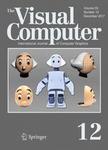版权所有:内蒙古大学图书馆 技术提供:维普资讯• 智图
内蒙古自治区呼和浩特市赛罕区大学西街235号 邮编: 010021

作者机构:Czech Tech Univ Prague Czech Republic
出 版 物:《VISUAL COMPUTER》 (视觉计算机)
年 卷 期:2023年第39卷第8期
页 面:3359-3372页
核心收录:
学科分类:08[工学] 0835[工学-软件工程] 0812[工学-计算机科学与技术(可授工学、理学学位)]
基 金:Czech Science Foundation [GA18-20374S] Research Center for Informatics [CZ.02.1.01/0.0/0.0/16_019/0000765] Grant Agency of the Czech Technical University in Prague [SGS22/173/OHK3/3T/13]
主 题:Real-time rendering Ray tracing Remote rendering
摘 要:Novel view synthesis is frequently employed in video streaming, temporal upsampling, or virtual reality. We propose a new representation, potentially visible layered image (PVLI), that uses a combination of a potentially visible set of the scene geometry and layered color images. PVLI encodes the depth implicitly and enables cheap run-time reconstruction. Furthermore, PVLI can also be used to reconstruct pixel and layer connectivities, which is crucial for filtering and post-processing of the rendered images. We use PVLIs to achieve local and server-based real-time ray tracing. In the first case, PVLIs are used as a basis for temporal and spatial upsampling of ray-traced illumination. In the second case, PVLIs are compressed, streamed over the network, and then used by a thin client to perform temporal and spatial upsampling and to hide latency. To shade the view, we use path tracing, accounting for effects such as soft shadows, global illumination, and physically based refraction. Our method supports dynamic lighting, and up to a limited extent, it also handles view-dependent surface interactions.